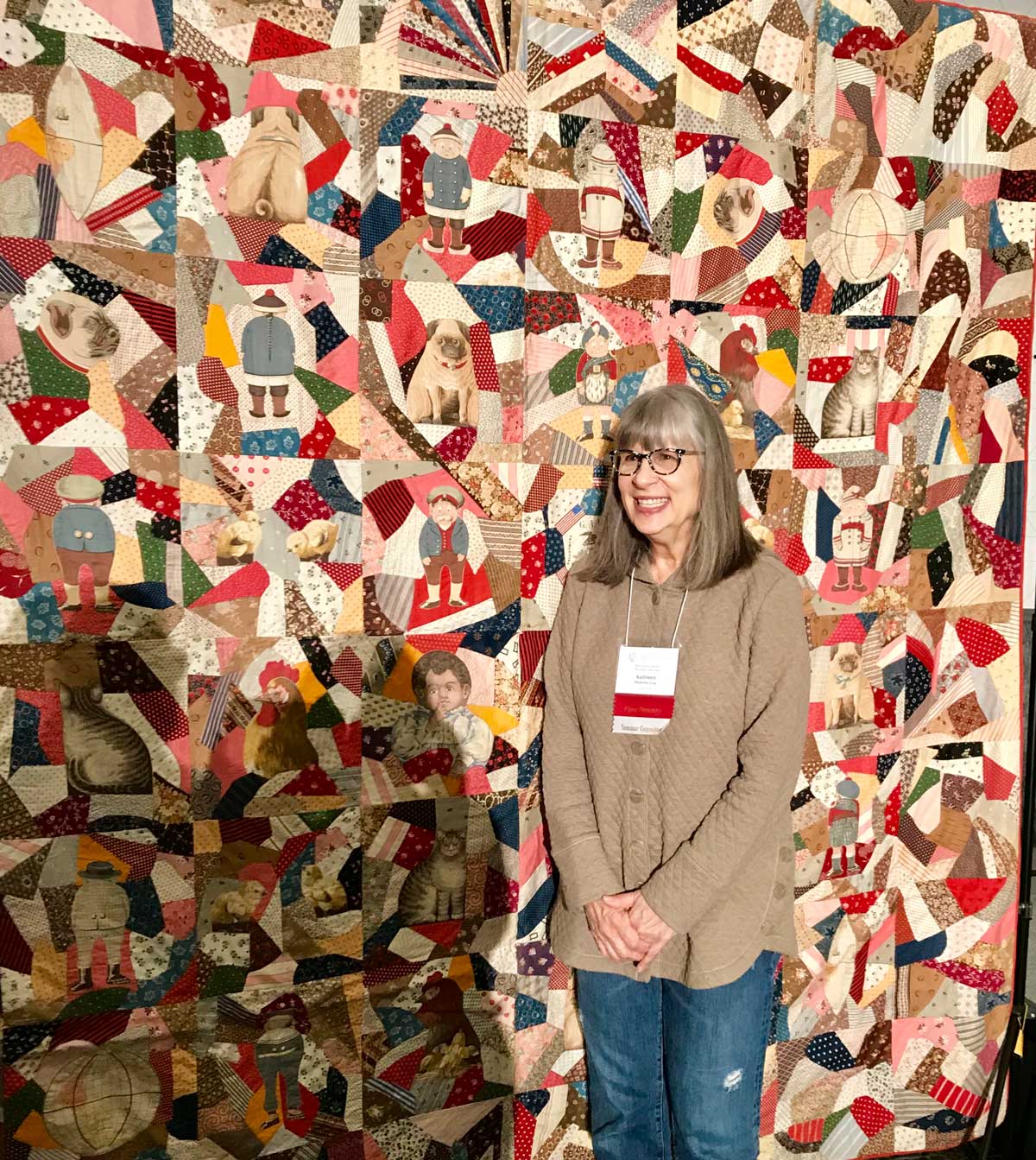Fall in love with New York – quilting adventures with the American Quilt Study, Part 2
December 2024
Covering Quilts
Fall in love with New York – quilting adventures with the American Quilt Study, Part 2
by Sandra Starley
Every fall, lovers of quilt history (old and new) meet to share research, treasures, and friendship at the Annual Meeting/Fall Seminar of the American Quilt Study Group (AQSG). Last month, I shared some of the wonderful experiences I had visiting this year’s meeting in New York’s beautiful Hudson River Valley, with tours of New York City and surrounding states.
As always, it was an amazing event full of old and new friends and a lot of antique quilts. In the previous article, I focused on the off-site tours, but there are many terrific events at the host hotel included with seminar registration — from Early Fabric Printing, 1840s Signature Quilts, 1890s Cut and Sew Dolls, to Quilts in Museums and Rotary Cutters in the 20th and 21st Century.
One of the highlights of every year’s seminar are the scholarly paper presentations, which are peer-reviewed research papers showcasing “the most recent advances in quilt-related research.” The papers are presented at seminar and published in Uncoverings, the annual academic journal of AQSG.
These papers represent years of intense research by the authors, who must condense and collate that information into the written word and then further distill the information to a brief Powerpoint talk at seminar. We were treated to a stellar group of talks on a variety of quilt history, both past and present, as indicated above. It was a delight to learn details about such a range of topics and time periods, from early 1800s lapis printing to contemporary Instagram posts about close encounters with rotary cutters.
I loved seeing images of the “Playthings by the Yard,” adorable cut-and-sew dolls and toys of the late 1800s and early 1900s. Of course, my personal favorite was Cathy Erickson’s presentation on 1840s signature quilts in Southeast Pennsylvania, a topic near and dear to my heart. And we each came home with a copy of Uncoverings to dive further into the research papers.
Great food and entertainment
Seminar also features wonderful food paired with informative luncheon and dinner speakers. This year we enjoyed a keynote speech by African-American quilt artist Dr. Myrah Brown Green, speaking on “The Presence of African Symbols in North American Quilts.” The first luncheon speaker was the Quilt Journalist Meg Cox giving one of her State of the Quilt Union updates aka the Quilt Journalist Tells All -Seminar Edition, an interesting and timely update of the status of the quilting industry. Dr. Janneken Smucker took us back in time a century, speaking on “A New Deal for Quilts: How Quilting Helped Rebuild America in the New Deal Era” (check out her amazing book of the same title).

Kathy Cray with her Quilted Playthings quilt, featuring cut-and-sew panels, circa 1890. (Image courtesy of the author)
And speaking of entertainment, remember the earlier mention of the Headless Horseman? That local denizen of Sleepy Hollow visited us as part of the Live Auction along with the auctioneering Statue of Liberty (Dana Balsamo) and the high-kicking Rockettes (aka Juliettes) assisting the head Rockette, our other auctioneer Julie Silber. Their snappy outfits and dancing made for a lively evening and helped raise serious funding for AQSG thanks to our generous members.
There were wonderful antique and contemporary quilts up for auction along with an amazing 1850 fabric factory swatch book donated by noted reproduction fabric designer Jo Morton.
Tune in next month to learn about the study centers, the silent auction, the vendors mall, and more.
Sandra Starley is nationally certified quilt appraiser, quilt historian, and avid antique quilt collector. She travels throughout the U.S. presenting talks on antique quilt history, fabric dating classes and trunk shows as well as quilting classes. Learn more at utahquiltappraiser.blogspot.com. Send your comments and quilt questions to SandraStarley@outlook.com
The Rolling Stone Quilt Pattern
November 2023 Covering Quilts The Rolling Stone Quilt Pattern by Sandra Starley As I noted in last month’s column, the Rolling Stone block is a classic early pattern that has been popular for more than 170 years. Part of its appeal is the simple, aka easy piecing:...
Rolling Stone Revisited
October 2023 Covering Quilts Rolling Stone Revisited by Sandra Starley Rolling Stone is a classic early quilt pattern that has been gaining popularity for more than 170 years. The block can be constructed in two separate ways: as an even or uneven nine patch. Both...
French Star or American Star revisited
September 2023Covering Quilts French Star or American Star revisited by Sandra Starley One of my all-time favorite antique quilt patterns is the French Star. I love sharing information about the block and hope to uncover more antique quilts featuring this design. I...
Still crazy after all these years! Crazy Quilts – Part II
August 2023Covering Quilts Still crazy after all these years! Crazy Quilts - Part II by Sandra Starley Crazy Quilts have been an iconic part of quilt history since the 1800s. Similarly, Discover Vintage America has been a sustained force in antiques and history since...
Crazy quilts showcase beauty in irregularity
July 2023 Covering Quilts Crazy quilts showcase beauty in irregularity by Sandra Starley What do a Victorian parlor, a Wizard of Oz char-acter, and a Batman villain have in common? Crazy Quilts! From ladies’ magazines in the 1880s to The Patchwork Girl of Oz in...
Classic patterns made modern – Rocky Road to Kansas
June 2023Covering Quilts Classic patterns made modern – Rocky Road to Kansas by Sandra Starley Last month, I wrote about the origins of the classic antique quilt pattern, Rocky Road To Kansas. While it sounds like a design dating back to the pioneer days of...

